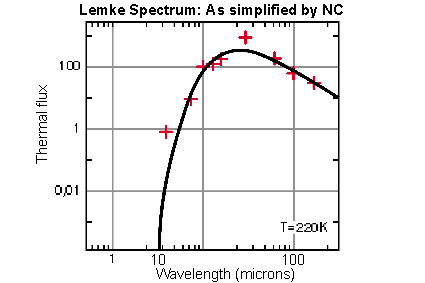COMET HALE-BOPP
 (Hi-Res: Postscript) (Hi-Res: Postscript) |
ISOCAM infrared image at 15 microns, 1 October 1996
Credits: ISO (ESA). P. Lamy and the Hale-Bopp team
image processed by B. Altieri at ESA Villafranca
|
| N.B. Click on a picture to view a larger image |
| |
 |
 |
Hubble image by visible light,
23 September 1996
Field is 21000 km wide
credits: HST (NASA & ESA),
H.Weaver and WFPC2 Team
|
ISOPHOT infrared spectrum, 2.5-200 microns
7-15 October 1996
Emission peak at 25 microns
credits: ISO (ESA)
E. Grün and the Hale-Bopp Team
|
ISO VIEWS COMET HALE-BOPP BY INFRARED LIGHT
The main image is from ISOís camera ISOCAM, and it is one of a series obtained at various infrared wavelengths in October 1996.
Analysis of the images is still in progress, but the chief feature is the cloud of dust in the cometís head (coma).
The bright region is about 100,000 kilometres across, or more than seven times wider than the Earth.
At the time the tail of Comet Hale-Bopp was largely hidden behind the coma, because of the
relative angles of the comet, the Sun and the Earth.
An image by visible light, obtained by the Hubble Space Telescope just a week earlier, is shown for comparison.
It covers a region of the sky (and the comet) one-fifth as wide as the ISO image.
At least five jets of dust are seen emanating from the cometís nucleus, and lit by sunlight.
The third item is a spectrum covering a huge range of infrared wavelengths from ISOís photometer ISOPHOT.
Here the instrument operates as a thermometer, taking the temperature of the cometís dust cloud.
The crosses are the measurements by ISOPHOT and the continous line is the emission expected from an object with a
temperature of 220 Kelvin, or about minus 50 degrees C.
By this period of observation in October 1996, the dust cloud was much warmer than in March 1996, when the same
instrument obtained a temperature of minus 120 degrees C.
The Infrared Space Observatory ISO was developed by the
European Space Agency and Europeís aerospace industry, equipped with instruments by four multinational teams of scientists,
and put into orbit by an Ariane launcher in November 1995. It is now in its second year of
operations. These are expected to terminate at the end of 1997 when the Helium coolant is exhausted.
| Credits: | ISOCAM image: | ISO (ESA), P. Lamy and the Hale-Bopp Team |
| | Hubble image: | HST (NASA & ESA), H. Weaver and the WFPC2 Team |
| | ISOPHOT spectrum: | ISO (ESA), E. Grün and the Hale-Bopp team |
 (Hi-Res: Postscript)
(Hi-Res: Postscript)
